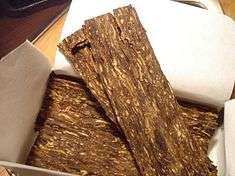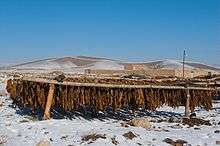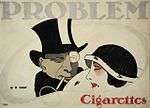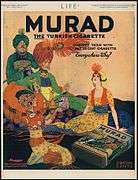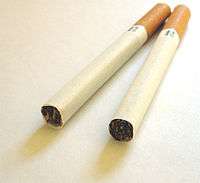Tobacco
| Tobacco | |
|---|---|
|
Tobacco flakes, sliced from pressed plugs | |
| Botanical name | Tobacco |
| Source plant(s) | Nicotiana |
| Part(s) of plant | leaf |
| Geographic origin | South America |
| Active ingredients | Nicotine, harmine |
| Uses | Recreational |
| Legal status |
|

Tobacco is a product prepared from the leaves of the tobacco plant by curing them. The plant is part of the genus Nicotiana and of the Solanaceae (nightshade) family. While more than 70 species of tobacco are known, the chief commercial crop is N. tabacum. The more potent variant N. rustica is also used around the world.
Tobacco contains the alkaloid nicotine, which is a stimulant. Dried tobacco leaves are mainly used for smoking in cigarettes, cigars, pipe tobacco, and flavored shisha tobacco. They can be also consumed as snuff, chewing tobacco, dipping tobacco and snus.
Tobacco use is a risk factor for many diseases, especially those affecting the heart, liver, and lungs, as well as many cancers. In 2008, the World Health Organization named tobacco as the world's single greatest preventable cause of death.[2]
Etymology
The English word "tobacco" originates from the Spanish and Portuguese word "tabaco". The precise origin of this word is disputed, but it is generally thought to have derived at least in part, from Taino, the Arawakan language of the Caribbean. In Taino, it was said to mean either a roll of tobacco leaves (according to Bartolomé de las Casas, 1552) or to tabago, a kind of Y-shaped pipe used for sniffing tobacco smoke (according to Oviedo; with the leaves themselves being referred to as cohiba).[3][4]
However, perhaps coincidentally, similar words in Spanish, Portuguese and Italian were used from 1410 to define medicinal herbs believed to have originated from the Arabic طُبّاق ṭubbāq (also طُباق ṭubāq), a word reportedly dating to the 9th century, as a name for various herbs.[5][6]
History
._Still_Life_with_Three_Castles_Tobacco%2C_1880.jpg)
Traditional use
Tobacco has long been used in the Americas, with some cultivation sites in Mexico dating back to 1400–1000 BC.[7] Many Native American tribes have traditionally grown and used tobacco. Eastern North American tribes have historically carried tobacco in pouches as a readily accepted trade item, as well as smoking it, both socially and ceremonially, such as to seal a peace treaty or trade agreement.[8][9] Traditionally, tobacco is seen as a gift from the Creator, with the ceremonial tobacco smoke carrying one's thoughts and prayers to the Creator.[10]
Popularization
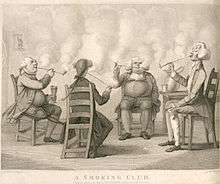

Following the arrival of the Europeans, tobacco became increasingly popular as a trade item. Hernández de Boncalo, Spanish chronicler of the Indies, was the first European to bring tobacco seeds to the Old World in 1559 following orders of King Philip II of Spain. These seeds were planted in the outskirts of Toledo, more specifically in an area known as "Los Cigarrales" named after the continuous plagues of cicadas (cigarras in Spanish). Before the development of lighter Virginia and white burley strains of tobacco, the smoke was too harsh to be inhaled. Small quantities were smoked at a time, using a pipe like the midwakh or kiseru or smoking newly invented waterpipes such as the bong or the hookah (see thuốc lào for a modern continuance of this practice).
Tobacco smoking, chewing, and snuffing became a major industry in Europe and its colonies by 1700.[11][12]
Tobacco has been a major cash crop in Cuba and in other parts of the Caribbean since the 18th century. Cuban cigars are world-famous.[13]
In the late 19th century, cigarettes became popular. James Bonsack created a machine that automated cigarette production. This increase in production allowed tremendous growth in the tobacco industry until the health revelations of the late-20th century.[14][15]
Contemporary
Following the scientific revelations of the mid-20th century, tobacco became condemned as a health hazard, and eventually became encompassed as a cause for cancer, as well as other respiratory and circulatory diseases. In the United States, this led to the Tobacco Master Settlement Agreement, which settled the lawsuit in exchange for a combination of yearly payments to the states and voluntary restrictions on advertising and marketing of tobacco products.
In the 1970s, Brown & Williamson cross-bred a strain of tobacco to produce Y1. This strain of tobacco contained an unusually high amount of nicotine, nearly doubling its content from 3.2-3.5% to 6.5%. In the 1990s, this prompted the Food and Drug Administration to use this strain as evidence that tobacco companies were intentionally manipulating the nicotine content of cigarettes.
In 2003, in response to growth of tobacco use in developing countries, the World Health Organization[16] successfully rallied 168 countries to sign the Framework Convention on Tobacco Control. The convention is designed to push for effective legislation and its enforcement in all countries to reduce the harmful effects of tobacco. This led to the development of tobacco cessation products.
Biology
Nicotiana

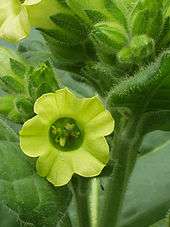
Many species of tobacco are in the genus of herbs Nicotiana. It is part of the nightshade family (Solanaceae) indigenous to North and South America, Australia, south west Africa, and the South Pacific.
Many plants contain nicotine, a powerful neurotoxin to insects. However, tobaccos contain a higher concentration of nicotine than most other plants. Unlike many other Solanaceae species, they do not contain tropane alkaloids, which are often poisonous to humans and other animals.
Despite containing enough nicotine and other compounds such as germacrene and anabasine and other piperidine alkaloids (varying between species) to deter most herbivores,[17] a number of such animals have evolved the ability to feed on Nicotiana species without being harmed. Nonetheless, tobacco is unpalatable to many species, and accordingly some tobacco plants (chiefly N. glauca) have become established as invasive weeds in some places.
Types
The types of tobacco include:
- Aromatic fire-cured is cured by smoke from open fires. In the United States, it is grown in northern middle Tennessee, central Kentucky, and Virginia. Fire-cured tobacco grown in Kentucky and Tennessee is used in some chewing tobaccos, moist snuff, some cigarettes, and as a condiment in pipe tobacco blends. Another fire-cured tobacco is Latakia, which is produced from oriental varieties of N. tabacum. The leaves are cured and smoked over smoldering fires of local hardwoods and aromatic shrubs in Cyprus and Syria.
- Brightleaf tobacco is commonly known as "Virginia tobacco", often regardless of the state where it is planted. Prior to the American Civil War, most tobacco grown in the US was fire-cured dark-leaf. Sometime after the War of 1812, demand for a milder, lighter, more aromatic tobacco arose. Ohio, Pennsylvania and Maryland all innovated with milder varieties of the tobacco plant. Farmers discovered that Bright leaf tobacco needs thin, starved soil, and those who could not grow other crops found that they could grow tobacco. Confederate soldiers traded it with each other and Union soldiers, and developed quite a taste for it. At the end of the war, the soldiers went home and a national market had developed for the local crop.
- Burley tobacco is an air-cured tobacco used primarily for cigarette production. In the U.S., burley tobacco plants are started from pelletized seeds placed in polystyrene trays floated on a bed of fertilized water in March or April.
- Cavendish is more a process of curing and a method of cutting tobacco than a type. The processing and the cut are used to bring out the natural sweet taste in the tobacco. Cavendish can be produced from any tobacco type, but is usually one of, or a blend of Kentucky, Virginia, and burley, and is most commonly used for pipe tobacco and cigars.
- Criollo tobacco is primarily used in the making of cigars. It was, by most accounts, one of the original Cuban tobaccos that emerged around the time of Columbus.
- Dokha is a tobacco originally grown in Iran, mixed with leaves, bark, and herbs for smoking in a midwakh.
- Turkish tobacco is a sun-cured, highly aromatic, small-leafed variety (Nicotiana tabacum) grown in Turkey, Greece, Bulgaria, and Macedonia. Originally grown in regions historically part of the Ottoman Empire, it is also known as "oriental". Many of the early brands of cigarettes were made mostly or entirely of Turkish tobacco; today, its main use is in blends of pipe and especially cigarette tobacco (a typical American cigarette is a blend of bright Virginia, burley, and Turkish).
- Perique was developed in 1824 through the technique of pressure-fermentation of local tobacco by a farmer, Pierre Chenet. Considered the truffle of pipe tobaccos, it is used as a component in many blended pipe tobaccos, but is too strong to be smoked pure. At one time, the freshly moist Perique was also chewed, but none is now sold for this purpose. It is typically blended with pure Virginia to lend spice, strength, and coolness to the blend.
- Shade tobacco is cultivated in Connecticut and Massachusetts. Early Connecticut colonists acquired from the Native Americans the habit of smoking tobacco in pipes, and began cultivating the plant commercially, though the Puritans referred to it as the "evil weed". The Connecticut shade industry has weathered some major catastrophes, including a devastating hailstorm in 1929, and an epidemic of brown spot fungus in 2000, but is now in danger of disappearing altogether, given the increase in the value of land.
- White burley air-cured leaf was found to be more mild than other types of tobacco. In 1865, George Webb of Brown County, Ohio planted red burley seeds he had purchased, and found a few of the seedlings had a whitish, sickly look, which became white burley.
- Wild tobacco is native to the southwestern United States, Mexico, and parts of South America. Its botanical name is Nicotiana rustica.
- Y1 is a strain of tobacco cross-bred by Brown & Williamson in the 1970s to obtain an unusually high nicotine content. In the 1990s, the United States Food and Drug Administration used it as evidence that tobacco companies were intentionally manipulating the nicotine content of cigarettes.[18]
Production
Cultivation
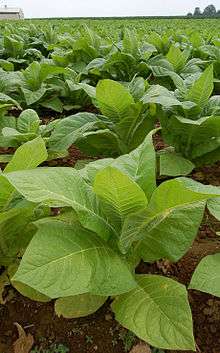
Tobacco is cultivated similarly to other agricultural products. Seeds were at first quickly scattered onto the soil. However, young plants came under increasing attack from flea beetles (Epitrix cucumeris or E. pubescens), which caused destruction of half the tobacco crops in United States in 1876. By 1890, successful experiments were conducted that placed the plant in a frame covered by thin cotton fabric. Today, tobacco is sown in cold frames or hotbeds, as their germination is activated by light.
In the United States, tobacco is often fertilized with the mineral apatite, which partially starves the plant of nitrogen, to produce a more desired flavor.
After the plants are about 8 in tall, they are transplanted into the fields. Farmers used to have to wait for rainy weather to plant. A hole is created in the tilled earth with a tobacco peg, either a curved wooden tool or deer antler. After making two holes to the right and left, the planter would move forward two feet, select plants from his/her bag, and repeat. Various mechanical tobacco planters like Bemis, New Idea Setter, and New Holland Transplanter were invented in the late 19th and 20th centuries to automate the process: making the hole, watering it, guiding the plant in — all in one motion.
Tobacco is cultivated annually, and can be harvested in several ways. In the oldest method still used today, the entire plant is harvested at once by cutting off the stalk at the ground with a tobacco knife. It is then speared onto sticks, four to six plants a stick and hung in a curing barn. In the 19th century, bright tobacco began to be harvested by pulling individual leaves off the stalk as they ripened. The leaves ripen from the ground upwards, so a field of tobacco harvested in this manner involves the serial harvest of a number of "primings", beginning with the volado leaves near the ground, working to the seco leaves in the middle of the plant, and finishing with the potent ligero leaves at the top. Before this, the crop must be topped when the pink flowers develop. Topping always refers to the removal of the tobacco flower before the leaves are systematically removed, and eventually, entirely harvested. As the industrial revolution took hold, harvesting wagons used to transport leaves were equipped with man-powered stringers, an apparatus that used twine to attach leaves to a pole. In modern times, large fields are harvested mechanically, although topping the flower and in some cases the plucking of immature leaves is still done by hand. Most tobacco in the U.S. is grown in North Carolina, Kentucky, and Virginia.[19]
Curing
Curing and subsequent aging allow for the slow oxidation and degradation of carotenoids in tobacco leaf. This produces certain compounds in the tobacco leaves, and gives a sweet hay, tea, rose oil, or fruity aromatic flavor that contributes to the "smoothness" of the smoke. Starch is converted to sugar, which glycates protein, and is oxidized into advanced glycation endproducts (AGEs), a caramelization process that also adds flavor. Inhalation of these AGEs in tobacco smoke contributes to atherosclerosis and cancer.[20] Levels of AGEs are dependent on the curing method used.
Tobacco can be cured through several methods, including:
- Air-cured tobacco is hung in well-ventilated barns and allowed to dry over a period of four to eight weeks. Air-cured tobacco is low in sugar, which gives the tobacco smoke a light, mild flavor, and high in nicotine. Cigar and burley tobaccos are 'dark' air-cured.[21]
- Fire-cured tobacco is hung in large barns where fires of hardwoods are kept on continuous or intermittent low smoulder, and takes between three days and ten weeks, depending on the process and the tobacco. Fire curing produces a tobacco low in sugar and high in nicotine. Pipe tobacco, chewing tobacco, and snuff are fire-cured.
- Flue-cured tobacco was originally strung onto tobacco sticks, which were hung from tier-poles in curing barns (Aus: kilns, also traditionally called 'oasts'). These barns have flues run from externally fed fire boxes, heat-curing the tobacco without exposing it to smoke, slowly raising the temperature over the course of the curing. The process generally takes about a week. This method produces cigarette tobacco that is high in sugar and has medium to high levels of nicotine. Most cigarettes incorporate flue-cured tobacco, which produces a milder, more inhalable smoke.
- Sun-cured tobacco dries uncovered in the sun. This method is used in Turkey, Greece, and other Mediterranean countries to produce oriental tobacco. Sun-cured tobacco is low in sugar and nicotine and is used in cigarettes.
Global production
Trends

Production of tobacco leaf increased by 40% between 1971, when 4.2 million tons of leaf were produced, and 1997, when 5.9 million tons of leaf were produced.[22] According to the Food and Agriculture organization of the UN, tobacco leaf production was expected to hit 7.1 million tons by 2010. This number is a bit lower than the record-high production of 1992, when 7.5 million tons of leaf were produced.[23] The production growth was almost entirely due to increased productivity by developing nations, where production increased by 128%.[24] During that same time, production in developed countries actually decreased.[23] China's increase in tobacco production was the single biggest factor in the increase in world production. China's share of the world market increased from 17% in 1971 to 47% in 1997.[22] This growth can be partially explained by the existence of a high import tariff on foreign tobacco entering China. While this tariff has been reduced from 64% in 1999 to 10% in 2004,[25] it still has led to local, Chinese cigarettes being preferred over foreign cigarettes because of their lower cost.
Major producers
| Top tobacco producers, 2012[26] | ||||
|---|---|---|---|---|
| Country | Production (tonnes) | Note | ||
| | 3,200,000 | |||
| | 875,000 | F | ||
| | 810,550 | |||
| | 345,837 | |||
| | 226,700 | |||
| | 151,150 | |||
| | 148,000 | F | ||
| | 120,000 | |||
| | 115,000 | F | ||
| World | 7,490,661.35 | A | ||
| No note = official figure, F = FAO Estimate, A = Aggregate (may include official, semiofficial or estimates). | ||||
Every year, about 6.7 million tons of tobacco are produced throughout the world. The top producers of tobacco are China (39.6%), India (8.3%), Brazil (7.0%) and the United States (4.6%).[27]
China
Around the peak of global tobacco production, 20 million rural Chinese households were producing tobacco on 2.1 million hectares of land.[28] While it is the major crop for millions of Chinese farmers, growing tobacco is not as profitable as cotton or sugarcane, because the Chinese government sets the market price. While this price is guaranteed, it is lower than the natural market price, because of the lack of market risk. To further control tobacco in their borders, China founded a State Tobacco Monopoly Administration (STMA) in 1982. The STMA controls tobacco production, marketing, imports, and exports, and contributes 12% to the nation's national income.[29] As noted above, despite the income generated for the state by profits from state-owned tobacco companies and the taxes paid by companies and retailers, China's government has acted to reduce tobacco use.[30]
India
India's Tobacco Board is headquartered in Guntur in the state of Andhra Pradesh.[31] India has 96,865 registered tobacco farmers[32] and many more who are not registered. In 2010, 3,120 tobacco product manufacturing facilities were operating in all of India.[33] Around 0.25% of India's cultivated land is used for tobacco production.[34]
Since 1947, the Indian government has supported growth in the tobacco industry. India has seven tobacco research centers, located in Tamil Nadu, Andhra Pradesh, Punjab, Bihar, Mysore, West Bengal, and Rajamundry.[32] Rajahmundry houses the core research institute. The government has set up a Central Tobacco Promotion Council, which works to increase exports of Indian tobacco.
Brazil
In Brazil, around 135,000 family farmers cite tobacco production as their main economic activity.[28] Tobacco has never exceeded 0.7% of the country's total cultivated area.[35] In the southern regions of Brazil, Virginia, and Amarelinho, flue-cured tobacco, as well as burley and Galpão Comum air-cured tobacco, are produced. These types of tobacco are used for cigarettes. In the northeast, darker, air- and sun-cured tobacco is grown. These types of tobacco are used for cigars, twists, and dark cigarettes.[35] Brazil's government has made attempts to reduce the production of tobacco, but has not had a successful systematic antitobacco farming initiative. Brazil's government, however, provides small loans for family farms, including those that grow tobacco, through the Programa Nacional de Fortalecimento da Agricultura Familiar.[36]

Problems in production
Child labor
The International Labour Office reported that the most child-laborers work in agriculture, which is one of the most hazardous types of work.[37] The tobacco industry houses some of these working children. Use of children is widespread on farms in Argentina, Brazil, China, India, Indonesia, Malawi, and Zimbabwe.[38] While some of these children work with their families on small, family-owned farms, others work on large plantations. In late 2009, reports were released by the London-based human-rights group Plan International, claiming that child labor was common on Malawi (producer of 1.8% of the world's tobacco[22]) tobacco farms. The organization interviewed 44 teens, who worked full-time on farms during the 2007-8 growing season. The child-laborers complained of low pay and long hours, as well as physical and sexual abuse by their supervisors.[39] They also reported suffering from Green tobacco sickness, a form of nicotine poisoning. When wet leaves are handled, nicotine from the leaves gets absorbed in the skin and causes nausea, vomiting, and dizziness. Children were exposed to 50-cigarettes-worth of nicotine through direct contact with tobacco leaves. This level of nicotine in children can permanently alter brain structure and function.[37]
Economy
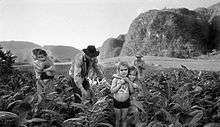
Major tobacco companies have encouraged global tobacco production. Philip Morris, British American Tobacco, and Japan Tobacco each own or lease tobacco-manufacturing facilities in at least 50 countries and buy crude tobacco leaf from at least 12 more countries.[40] This encouragement, along with government subsidies, has led to a glut in the tobacco market. This surplus has resulted in lower prices, which are devastating to small-scale tobacco farmers. According to the World Bank, between 1985 and 2000, the inflation-adjusted price of tobacco dropped 37%.[41] Tobacco is the most widely smuggled legal product.[42]
Environment
Tobacco production requires the use of large amounts of pesticides. Tobacco companies recommend up to 16 separate applications of pesticides just in the period between planting the seeds in greenhouses and transplanting the young plants to the field.[43] Pesticide use has been worsened by the desire to produce larger crops in less time because of the decreasing market value of tobacco. Pesticides often harm tobacco farmers because they are unaware of the health effects and the proper safety protocol for working with pesticides. These pesticides, as well as fertilizers, end up in the soil, waterways, and the food chain.[44] Coupled with child labor, pesticides pose an even greater threat. Early exposure to pesticides may increase a child's lifelong cancer risk, as well as harm his or her nervous and immune systems.[45]
Tobacco crops extract nutrients (such as phosphorus, nitrogen, and potassium) from soil, decreasing its fertility.[46]
Furthermore, the wood used to cure tobacco in some places leads to deforestation. While some big tobacco producers such as China and the United States have access to petroleum, coal, and natural gas, which can be used as alternatives to wood, most developing countries still rely on wood in the curing process.[46] Brazil alone uses the wood of 60 million trees per year for curing, packaging, and rolling cigarettes.[43]
Research
Several tobacco plants have been used as model organisms in genetics. Tobacco BY-2 cells, derived from N. tabacum cultivar 'Bright Yellow-2', are among the most important research tools in plant cytology.[47] Tobacco has played a pioneering role in callus culture research and the elucidation of the mechanism by which kinetin works, laying the groundwork for modern agricultural biotechnology. The first genetically modified plant was produced in 1982, using Agrobacterium tumefaciens to create an antibiotic-resistant tobacco plant.[48] This research laid the groundwork for all genetically modified crops.[49]
Genetic modification
Because of its importance as a research tool, transgenic tobacco was the first GM crop to be tested in field trials, in the United States and France in 1986; China became the first country in the world to approve commercial planting of a GM crop in 1993, which was tobacco.[50]
Field trials
Many varieties of transgenic tobacco have been intensively tested in field trials. Agronomic traits such as resistance to pathogens (viruses, particularly to the tobacco mosaic virus (TMV); fungi; bacteria and nematodes); weed management via herbicide tolerance; resistance against insect pests; resistance to drought and cold; and production of useful products such as pharmaceuticals; and use of GM plants for bioremediation, have all been tested in over 400 field trials using tobacco.[51]
Production
Currently, only the US is producing GM tobacco.[50][51] The Chinese virus-resistant tobacco was withdrawn from the market in China in 1997.[52]:3 In the US, cigarettes made with GM tobacco with reduced nicotine content are available under the market name Quest.[51]
Consumption
Tobacco is consumed in many forms and through a number of different methods. Some examples are:
- Beedi are thin, often flavoured cigarettes from India made of tobacco wrapped in a tendu leaf, and secured with coloured thread at one end.
- Chewing tobacco is the oldest way of consuming tobacco leaves. It is consumed orally, in two forms: through sweetened strands, or in a shredded form. When consuming the long, sweetened strands, the tobacco is lightly chewed and compacted into a ball. When consuming the shredded tobacco, small amounts are placed at the bottom lip, between the gum and the teeth, where it is gently compacted, thus it can often be called dipping tobacco. Both methods stimulate the salivary glands, which led to the development of the spittoon.
- Cigars are tightly rolled bundles of dried and fermented tobacco, which are ignited so their smoke may be drawn into the smokers' mouths.
- Cigarettes are a product consumed through inhalation of smoke and manufactured from cured and finely cut tobacco leaves and reconstituted tobacco, often combined with other additives, then rolled into a paper cylinder.
- Creamy snuffs are tobacco paste, consisting of tobacco, clove oil, glycerin, spearmint, menthol, and camphor, and sold in a toothpaste tube. It is marketed mainly to women in India, and is known by the brand names Ipco (made by Asha Industries), Denobac, Tona, and Ganesh. It is locally known as mishri in some parts of Maharashtra.
- Dipping tobaccos are a form of smokeless tobacco. Dip is occasionally referred to as "chew", and because of this, it is commonly confused with chewing tobacco, which encompasses a wider range of products. A small clump of dip is 'pinched' out of the tin and placed between the lower or upper lip and gums. Some brands, as with snus, are portioned in small, porous pouches for less mess.
- Gutka is a preparation of crushed betel nut, tobacco, and sweet or savory flavorings. It is manufactured in India and exported to a few other countries. A mild stimulant, it is sold across India in small, individual-sized packets.
- Hookah is a single- or multistemmed (often glass-based) water pipe for smoking. Hookahs were first used in India and Persia;[53] the hookah has gained immense popularity, especially in the Middle East. A hookah operates by water filtration and indirect heat. It can be used for smoking herbal fruits or moassel, a mixture of tobacco, flavouring, and honey or glycerin.
- Kreteks are cigarettes made with a complex blend of tobacco, cloves, and a flavoring "sauce". It was first introduced in the 1880s in Kudus, Java, to deliver the medicinal eugenol of cloves to the lungs.
- Roll-your-own, often called 'rollies' or 'roll-ups', are relatively popular in some European countries. These are prepared from loose tobacco, cigarette papers, and filters all bought separately. They are usually cheaper to make.
- Pipe smoking typically consists of a small chamber (the bowl) for the combustion of the tobacco to be smoked and a thin stem (shank) that ends in a mouthpiece (the bit). Shredded pieces of tobacco are placed into the chamber and ignited.
- Snuff is a ground smokeless tobacco product, inhaled or "snuffed" through the nose. If referring specifically to the orally consumed moist snuff, see dipping tobacco.
- Snus is a steam-cured moist powdered tobacco product that is not fermented, and induces minimal salivation. It is consumed by placing it (loose or in little pouches) against the upper gums for an extended period of time. It is somewhat similar to dipping tobacco but does not require spitting and is significantly lower in TSNAs.
- Tobacco edibles, often it the form of an infusion or a spice, have gained popularity in recent years.
- Topical tobacco paste is sometimes used as a treatment for wasp, hornet, fire ant, scorpion, and bee stings.[54] An amount equivalent to the contents of a cigarette is mashed in a cup with about a half a teaspoon of water to make a paste that is then applied to the affected area.
- Tobacco water is a traditional organic insecticide used in domestic gardening. Tobacco dust can be used similarly. It is produced by boiling strong tobacco in water, or by steeping the tobacco in water for a longer period. When cooled, the mixture can be applied as a spray, or 'painted' on to the leaves of garden plants, where it kills insects. Tobacco is, however, banned from use as pesticide in certified organic production.[55]
Impact
Social
Smoking in public was, for a long time, reserved for men, and when done by women was sometimes associated with promiscuity; in Japan, during the Edo period, prostitutes and their clients often approached one another under the guise of offering a smoke. The same was true in 19th-century Europe.[56]
Following the American Civil War, the use of tobacco, primarily in cigars, became associated with masculinity and power. Today, tobacco is often rejected; this has spawned quitting associations and antismoking campaigns.[57][58] Bhutan is the only country in the world where tobacco sales are illegal.[59]
Demographic
Research on tobacco use is limited mainly to smoking, which has been studied more extensively than any other form of consumption. An estimated 1.1 billion people, and up to one-third of the adult population, use tobacco in some form.[60] Smoking is more prevalent among men[61] (however, the gender gap declines with age),[62][63] the poor, and in transitional or developing countries[64]
Rates of smoking continue to rise in developing countries, but have leveled off or declined in developed countries.[65] Smoking rates in the United States have dropped by half from 1965 to 2006, falling from 42% to 20.8% in adults.[66] In the developing world, tobacco consumption is rising by 3.4% per year.[67]
Harmful effects of tobacco and smoking
Tobacco smoking poses a risk to health due to the inhalation of poisonous chemicals in tobacco smoke such as Carbon Monoxide, Cyanide, and Carcinogens which have been proven to cause heart and lung diseases and Cancer. According to the World Health Organization (WHO), tobacco is the single greatest cause of preventable death globally.[68] The WHO estimates that tobacco caused 5.4 million deaths in 2004[69] and 100 million deaths over the course of the 20th century.[70] Similarly, the United States Centers for Disease Control and Prevention describe tobacco use as "the single most important preventable risk to human health in developed countries and an important cause of premature death worldwide."[71]
The harms caused by inhalation of poisonous chemicals such as Carbon Monoxide in tobacco smoke include diseases affecting the heart and lungs, with smoking being a major risk factor for heart attacks, strokes, chronic obstructive pulmonary disease, emphysema, and cancer (particularly lung cancer, cancers of the larynx and mouth, and pancreatic cancers). Cancer is caused by inhaling carcinogenic substances present in tobacco smoke.
Inhaling secondhand tobacco smoke can cause lung cancer in nonsmoking adults. In the United States, about 3,000 adults die each year due to lung cancer from secondhand smoke exposure. Heart disease caused by secondhand smoke kills around 46,000 nonsmokers every year.[72]
The addictive alkaloid nicotine is a stimulant, and popularly known as the most characteristic constituent of tobacco. Users may develop tolerance and dependence.[73][74] Thousands of different substances in cigarette smoke, including polycyclic aromatic hydrocarbons (such as benzopyrene), formaldehyde, cadmium, nickel, arsenic, tobacco-specific nitrosamines, and phenols contribute to the harmful effects of smoking.[75]
Economic
"Much of the disease burden and premature mortality attributable to tobacco use disproportionately affect the poor", and of the 1.22 billion smokers, 1 billion of them live in developing or transitional economies.[64]
Smoking of tobacco is practised worldwide by over one thousand million people. However, while smoking prevalence has declined in many developed countries, it remains high in others and is increasing among women and in developing countries. Between one-fifth and two-thirds of men in most populations smoke. Women's smoking rates vary more widely but rarely equal male rates.[76]
In Indonesia, the lowest income group spends 15% of its total expenditures on tobacco. In Egypt, more than 10% of households' expenditure in low-income homes is on tobacco. The poorest 20% of households in Mexico spend 11% of their income on tobacco.[77]
Advertising
Tobacco advertising of tobacco products by the tobacco industry is through a variety of media, including sponsorship, particularly of sporting events. It is now one of the most highly regulated forms of marketing. Some or all forms of tobacco advertising are banned in many countries.
|
Cinema
Gallery
|
References
- ↑ "Youth Tobacco Prevention: Underage Prevention Laws". Transform Tobacco. Retrieved 4 December 2016.
As of August 2014, all but eight states had laws prohibiting minors from purchasing tobacco: Alaska, Colorado, Massachusetts, Nevada, New Jersey, New York, Rhode Island, and West Virginia. All but eleven states had youth tobacco possession laws in place. These are Delaware, Hawaii, Massachusetts, Minnesota, Nevada, New Jersey, New Mexico, New York, North Carolina, Tennessee and Pennsylvania. More troubling, there are still six states which prohibit youth from possessing tobacco, but allow for an exemption where parents or guardians give permission for that possession: Delaware, Georgia, Kentucky, Louisiana, Ohio, and Texas.
- ↑ "WHO Report on the global tobacco epidemic, 2008 (foreword and summary)" (PDF). World Health Organization. 2008: 8.
Tobacco is the single most preventable cause of death in the world today.
- ↑ "World Association of International Studies, Stanford University".
- ↑ Ernst, A. (1889). "On the etymology of the word tobacco". The American Anthropologist. A2 (2): 133–142. doi:10.1525/aa.1889.2.2.02a00020.
- ↑ Lane's Lexicon. page 1879.
- ↑ The word ṭubāq no longer refers to various herbs, but has come to refer, in some dialects, specifically to tobacco. See Hans Wehr's Dictionary of Modern Written Arabic. page 647.
- ↑ Goodman, Jordan. Tobacco in History and Culture: An Encyclopedia (Detroit: Thomson Gale, 2005).
- ↑ e.g. Heckewelder, History, Manners and Customs of the Indian Nations who Once Inhabited Pennsylvania, p. 149 ff.
- ↑ "They smoke with excessive eagerness ... men, women, girls and boys, all find their keenest pleasure in this way." - Dièreville describing the Mi'kmaq, circa 1699 in Port Royal.
- ↑ Jack Jacob Gottsegen, Tobacco: A Study of Its Consumption in the United States, 1940, p. 107.
- ↑ Eric Burns, The Smoke of the Gods: A Social History of Tobacco (2006), A popular history focused on the US.
- ↑ Jordan Goodman, Tobacco in History: The Cultures of Dependence (1993), A scholarly history worldwide.
- ↑ Charlotte Cosner, The Golden Leaf: How Tobacco Shaped Cuba and the Atlantic World (Vanderbilt University Press; 2015)
- ↑ Richard Kluger, Ashes to Ashes: America's Hundred-Year Cigarette War (1996)
- ↑ Allan Brandt, The Cigarette Century: The Rise, Fall, and Deadly Persistence of the Product That Defined America (2007)
- ↑ "WHO | WHO Framework Convention on Tobacco Control (WHO FCTC)". Who.int. Retrieved 2008-09-18.
- ↑ Panter, KE; Keeler, RF; Bunch, TD; Callan, RJ (1990). Congenital skeletal malformations and cleft palate induced in goats by ingestion of Lupinus, Conium and Nicotiana species. PubMed. 28. pp. 1377–1385. PMID 2089736.
- ↑ "Inside the Tobacco Deal - interview with David Kessler". PBS. 2008. Retrieved 2008-06-11.
- ↑ "Tobacco-growing states in the USA" (PDF). Campaign for Tobacco-Free Kids.
- ↑ Cerami C, Founds H, Nicholl I, Mitsuhashi T, Giordano D, Vanpatten S, Lee A, Al-Abed Y, Vlassara H, Bucala R, Cerami A (1997). "Tobacco smoke is a source of toxic reactive glycation products". Proceedings of the National Academy of Sciences of the United States of America. 94 (25): 13915–20. doi:10.1073/pnas.94.25.13915. PMC 28407
 . PMID 9391127.
. PMID 9391127. - ↑ "tobacco curing." The Hutchinson Unabridged Encyclopedia with Atlas and Weather guide. Abington: Helicon, 2010. Credo Reference. Web. 26 September 2012.
- 1 2 3 Food and Agriculture Organization of the United Nations. "Projection of tobacco production, consumption and trade for the year 2010." Rome, 2003.
- 1 2 The Food and Agriculture Organization of the United Nations.Higher World Tobacco use expected by 2010-growth rates slowing down." (Rome, 2004).
- ↑ Rowena Jacobs; et al. (2000). "The Supply-Side Effects Of Tobacco Control Policies". In Prabhat Jha; Frank J. Chaloupka. Tobacco Control in Developing Countries. New York: Oxford University Press. pp. 311ff. ISBN 978-0-19-263250-0.
- ↑ Hu T-W, Mao Z, et al. "China at the Crossroads: The Economics of Tobacco and Health". Tobacco Control. 2006;15:i37–i41.
- ↑ "FAOSTAT". Food And Agriculture Organization Of The United Nations. Retrieved 19 May 2014.
- ↑ US Census Bureau-Foreign Trade Statistics, (Washington DC; 2005)
- 1 2 Food and Agriculture Organization of the United Nations. "Issues in the Global Tobacco Economy."
- ↑ "People's Republic of China. "''State Tobacco Monopoly Administration''". Gov.cn. 2005-09-15. Retrieved 2013-10-03.
- ↑ USC U.S.-China Institute, "Talking Points, February 3–17, 2010: http://china.usc.edu/ShowArticle.aspx?articleID=1992
- ↑ "Tobacco Board, Guntur". Tobaccoboard.com. Retrieved 2014-04-21.
- 1 2 Shoba, John and Shailesh Vaite. Tobacco and Poverty: Observations from India and Bangladesh. Canada, 2002.
- ↑ "Tobacco Manufacturing in India".
- ↑ 3.Food and Agriculture Organization of the United Nations. "Issues in the Global Tobacco Economy."
- 1 2 International Tobacco Growers' Association (n.d.). Tobacco farming: sustainable alternatives? Volume 2 (PDF). East Sussex: ITGA. ISBN 1872854028.
- ↑ High Level Commission on Legal Empowerment of the Poor. "Report from South America." 2006.
- 1 2 ILO. International Hazard Datasheets on Occupations: Field Crop Worker
- ↑ UNICEF, The State of the World's Children 1997 (Oxford, 1997); US Department of Agriculture By the Sweat and Toil of Children Volume II: The Use of Child Labor in US Agricultural Imports & Forced and Bonded Child Labor (Washington, 1995); ILO Bitter Harvest: Child Labour in Agriculture (Geneva, 1997); ILO Child Labour on Commercial Agriculture in Africa (Geneva 1997)
- ↑ Plan International. Malawi Child Tobacco Pickers' '50-a-day habit http://plan-international.org/about-plan/resources/media-centre/press-releases/malawi-child-tobacco-pickers-50-a-day-habit/?searchterm=tobacco
- ↑ "International Cigarette Manufacturers," Tobacco Reporter, March 2001
- ↑ The Campaign for Tobacco Free Kids (November 2001). "Golden Leaf, Barren Harvest: The Costs of Tobacco Farming" (PDF).
- ↑ "Tobacco Underground". The International Consortium of Investigative Journalists. Retrieved November 26, 2012.
- 1 2 Taylor, Peter (September 1994). Smoke Ring: The Politics of Tobacco. London: Panos Briefing Paper.
- ↑ FAO Yearbook, Production, Volume 48. 1995.
- ↑ National Research Council (1995). Pesticides in the Diets of Infants and Children. National Academy Press.
- 1 2 World Health Organization. "Tobacco Free Initiative: Environmental issues".
- ↑ Ganapathi TR; et al. (2004). "Tobacco (Nicotiana tabacum L.) – A model system for tissue culture interventions and genetic engineering" (PDF). Indian Journal of Biotechnology. 3: 171–184.
- ↑ Fraley RT; et al. (1983). "Expression of bacterial genes in plant cells" (PDF). Proc. Natl. Acad. Sci. U.S.A. 80: 4803–4807.
- ↑ "Science of Transgenic Cotton". Cottoncrc.org.au. Retrieved 2013-10-03.
- 1 2 James, Clive (1996). "Global Review of the Field Testing and Commercialization of Transgenic Plants: 1986 to 1995" (PDF). The International Service for the Acquisition of Agri-biotech Applications. Retrieved 17 July 2010.
- 1 2 3 "Tobacco". GMO Compass. Retrieved 2013-10-03.
- ↑ Conner AJ, Glare TR, Nap JP (Jan 2003). "The release of genetically modified crops into the environment. Part II. Overview of ecological risk assessment". Plant J. 33 (1): 19–46. doi:10.1046/j.0960-7412.2002.001607.x. PMID 12943539.
- ↑ American Lung Association. February 2007 An Emerging Deadly Trend: Waterpipe Tobacco Use
- ↑ Beverly Sparks, "Stinging and Biting Pests of People" Extension Entomologist of the University of Georgia College of Agricultural & Environmental Sciences Cooperative Extension Service.
- ↑ "Generic Materials Search | Organic Materials Review Institute". Omri.org. Retrieved 2014-10-03. Archive
- ↑ Timon Screech, "Tobacco in Edo Period Japan" in Smoke, pp. 92-99
- ↑ Durkin Sarah; Brennan Emily; Wakefield Melanie (2012). "Mass media campaigns to promote smoking cessation among adults: an integrative review". Tobacco Control. 21 (2): 127–138. doi:10.1136/tobaccocontrol-2011-050345.
- ↑ Mullin Sandra (2011). "Global anti-smoking campaigns urgently needed". The Lancet. 378 (9795): 970–971. doi:10.1016/s0140-6736(11)61058-1.
- ↑ The First Nonsmoking Nation, Slate.com
- ↑ Saner L. Gilman and Zhou Xun, "Introduction" in Smoke; p. 26
- ↑ "Guindon & Boisclair" 2004, pp. 13-16.
- ↑ Women and the Tobacco Epidemic: Challenges for the 21st Century 2001, pp.5-6.
- ↑ Surgeon General's Report — Women and Smoking 2001, p.47.
- 1 2 "WHO/WPRO-Tobacco". World Health Organization Regional Office for the Western Pacific. 2005. Retrieved 2009-01-01.
- ↑ "Who Fact Sheet: Tobacco". Who.int. 2013-07-26. Retrieved 2013-10-03.
- ↑ "Cigarette Smoking Among Adults - United States, 2006". Cdc.gov. Retrieved 2013-10-03.
- ↑ "WHO/WPRO-Smoking Statistics". Wpro.who.int. 2002-05-27. Retrieved 2014-04-21.
- ↑ World Health Organization (2008). WHO Report on the Global Tobacco Epidemic 2008: The MPOWER Package (PDF). Geneva: World Health Organization. ISBN 92-4-159628-7.page 14
- ↑ "WHO global burden of disease report 2008" (PDF). Retrieved 2013-10-03.
- ↑ "WHO Report on the Global Tobacco Epidemic, 2008" (PDF). Retrieved 2013-10-03.
- ↑ "Nicotine: A Powerful Addiction." Centers for Disease Control and Prevention. Archive
- ↑ Secondhand Smoke by BeTobaccoFree.gov
- ↑ "Tobacco Facts - Why is Tobacco So Addictive?". Tobaccofacts.org. Retrieved 2008-09-18.
- ↑ "Philip Morris Information Sheet". Stanford.edu. Archived from the original on 2008-04-05. Retrieved 2008-09-18.
- ↑ Proctor Robert N (2012). "The history of the discovery of the cigarette-lung cancer link: evidentiary traditions, corporate denial, global toll" (PDF). Tobacco Control. 21: 87–91. doi:10.1136/tobaccocontrol-2011-050338. PMID 22345227.
- ↑ "Tobacco: Active and Passive Smoking". Greenfacts.org. Retrieved 5 July 2016.
- ↑ World Health Organization (2008). WHO Report on the Global Tobacco Epidemic 2008: The MPOWER Package (PDF). Geneva: World Health Organization. ISBN 92-4-159628-7. page 20
Further reading
- "WHO REPORT on the global TOBACCO epidemic" (PDF). World Health Organization. 2008. Retrieved 2008-01-01.
- "The Global Burden of Disease 2004 Update" (PDF). World Health Organization. 2008. Retrieved 2008-01-01.
- G. Emmanuel Guindon; David Boisclair (2003). "Past, current and future trends in tobacco use" (PDF). Washington DC: The International Bank for Reconstruction and Development / The World Bank. Retrieved 2008-01-02.
- The World Health Organization, and the Institute for Global Tobacco Control, Johns Hopkins School of Public Health (2001). "Women and the Tobacco Epidemic: Challenges for the 21st Century" (PDF). World Health Organization. Retrieved 2009-01-02.
- "Surgeon General's Report — Women and Smoking". Centers for Disease Control and Prevention. 2001. Retrieved 2009-01-03.
- Richard Peto; Alan D Lopez; Jillian Boreham; Michael Thun (2006). "Mortality from Smoking in Developed Countries 1950-2000: indirect estimates from national vital statistics" (PDF). New York, NY: Oxford University Press. Retrieved 2009-01-03.
- Gilman, Sander L.; Zhou, Xun (2004). Smoke: A Global History of Smoking. Reaktion Books. ISBN 978-1-86189-200-3. Retrieved 2009-01-01.
- "Cancer Facts & Figures 2015". American Cancer Society. Retrieved February 23, 2015.
- Paul Lichtenstein; Niels V. Holm; Pia K. Verkasalo; Anastasia Iliadou; Jaakko Kaprio; Markku Koskenvuo; Eero Pukkala; Axel Skytthe; Kari Hemminki (2000). Environmental and Heritable Factors in the Causation of Cancer — Analyses of Cohorts of Twins from Sweden, Denmark, and Finland. 343. New England Journal of Medicine. Retrieved 2009-01-21.
- Montesano, R.; Hall, J. (2001). "Environmental causes of human cancers". European Journal of Cancer. Retrieved 2009-01-21.
- Janet E. Ash; Maryadele J. O'Neil; Ann Smith; Joanne F. Kinneary (June 1997) [1996]. The Merck Index (12 ed.). Merk and Co. ISBN 0-412-75940-3.
- Benedict, Carol. Golden-Silk Smoke: A History of Tobacco in China, 1550-2010 (2011)
- Brandt, Allan. The Cigarette Century: The Rise, Fall, and Deadly Persistence of the Product That Defined America (2007)
- Breen, T. H. (1985). Tobacco Culture. Princeton University Press. ISBN 0-691-00596-6. Source on tobacco culture in 18th-century Virginia pp. 46–55
- Burns, Eric. The Smoke of the Gods: A Social History of Tobacco. Philadelphia: Temple University Press, 2007.
- Collins, W.K. and S.N. Hawks. "Principles of Flue-Cured Tobacco Production" 1st Edition, 1993
- Cosner, Charlotte. The Golden Leaf: How Tobacco Shaped Cuba and the Atlantic World (Vanderbilt University Press; 2015)
- Fuller, R. Reese (Spring 2003). Perique, the Native Crop. Louisiana Life.
- Gately, Iain. Tobacco: A Cultural History of How an Exotic Plant Seduced Civilization. Grove Press, 2003. ISBN 0-8021-3960-4.
- Goodman, Jordan. Tobacco in History:The Cultures of Dependence (1993), A scholarly history worldwide.
- Graves, John. "Tobacco that is not Smoked" in From a Limestone Ledge (the sections on snuff and chewing tobacco) ISBN 0-394-51238-3
- Grehan, James. Smoking and "Early Modern" Sociability: The Great Tobacco Debate in the Ottoman Middle East (Seventeenth to Eighteenth Centuries). The American Historical Review, Vol. III, Issue 5. 2006. 22 March 2008 online
- Hahn, Barbara. Making Tobacco Bright: Creating an American Commodity, 1617-1937 (Johns Hopkins University Press; 2011) 248 pages; examines how marketing, technology, and demand figured in the rise of Bright Flue-Cured Tobacco, a variety first grown in the inland Piedmont region of the Virginia-North Carolina border.
- Killebrew, J. B. and Myrick, Herbert (1909). Tobacco Leaf: Its Culture and Cure, Marketing and Manufacture. Orange Judd Company. Source for flea beetle typology (p. 243)
- Kluger, Richard. Ashes to Ashes: America's Hundred-Year Cigarette War (1996), Pulitzer Prize
- Murphey, Rhoads. Studies on Ottoman Society and Culture: 16th-18th Centuries. Burlington, VT: Ashgate: Variorum, 2007 ISBN 978-0-7546-5931-0 ISBN 0-7546-5931-3
- Neuburger, Mary, 2012. Balkan Smoke: tobacco and the making of modern Bulgaria. Cornell University Press. 0801450845, 9780801450846
- Poche, L. Aristee (2002). Perique tobacco: Mystery and history.
- Price, Jacob M. "The rise of Glasgow in the Chesapeake tobacco trade, 1707-1775." William and Mary Quarterly (1954) pp: 179-199. in JSTOR
- Tilley, Nannie May The Bright Tobacco Industry 1860–1929 ISBN 0-405-04728-2.
- Schoolcraft, Henry R. Historical and Statistical Information respecting the Indian Tribes of the United States (Philadelphia, 1851–57)
- Shechter, Relli. Smoking, Culture and Economy in the Middle East: The Egyptian Tobacco Market 1850–2000. New York: I.B. Tauris & Co. Ltd., 2006 ISBN 1-84511-137-0
External links
- International Tobacco Growers' Association
- Natural Resources Conservation Service Plant Sheet - Wild tobacco
- Ottoman Back Archives and Research Centre
- Questions on European Union partial ban on some smokeless tobacco products (i.e. snus)
- Timeline of tobacco history
- The European tobacco growers website
- The Legacy Tobacco Documents Library
- UCSF Tobacco Industry Videos Collection
- CDC - Smoking and Tobacco Use Fact Sheet
- TobReg - WHO Study Group on Tobacco Product Regulation
- - Statistics and general information about the effects of secondhand-smoke
- Scientists Search for Healthy Uses for Tobacco
- Charlton A (2004). "Medicinal uses of tobacco in history". J R Soc Med. 97: 292–6. doi:10.1258/jrsm.97.6.292. PMC 1079499
 . PMID 15173337.
. PMID 15173337.
